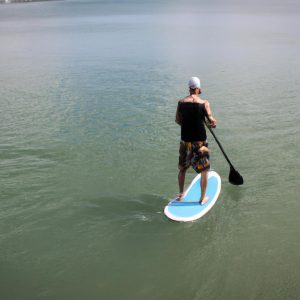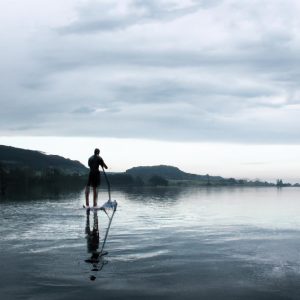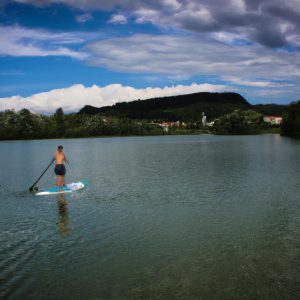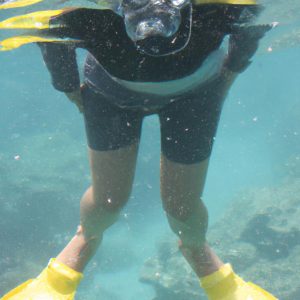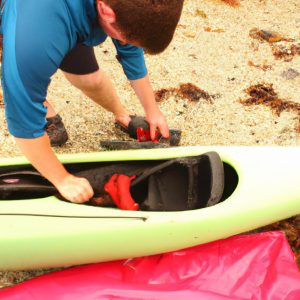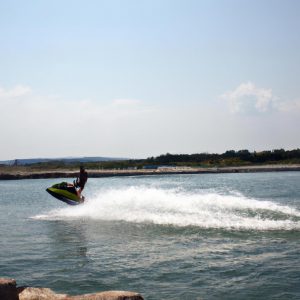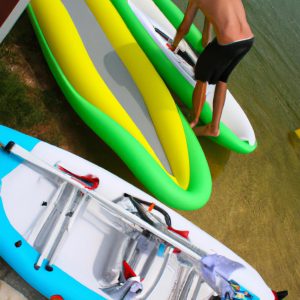Mastering Paddleboarding Techniques: A Comprehensive Guide
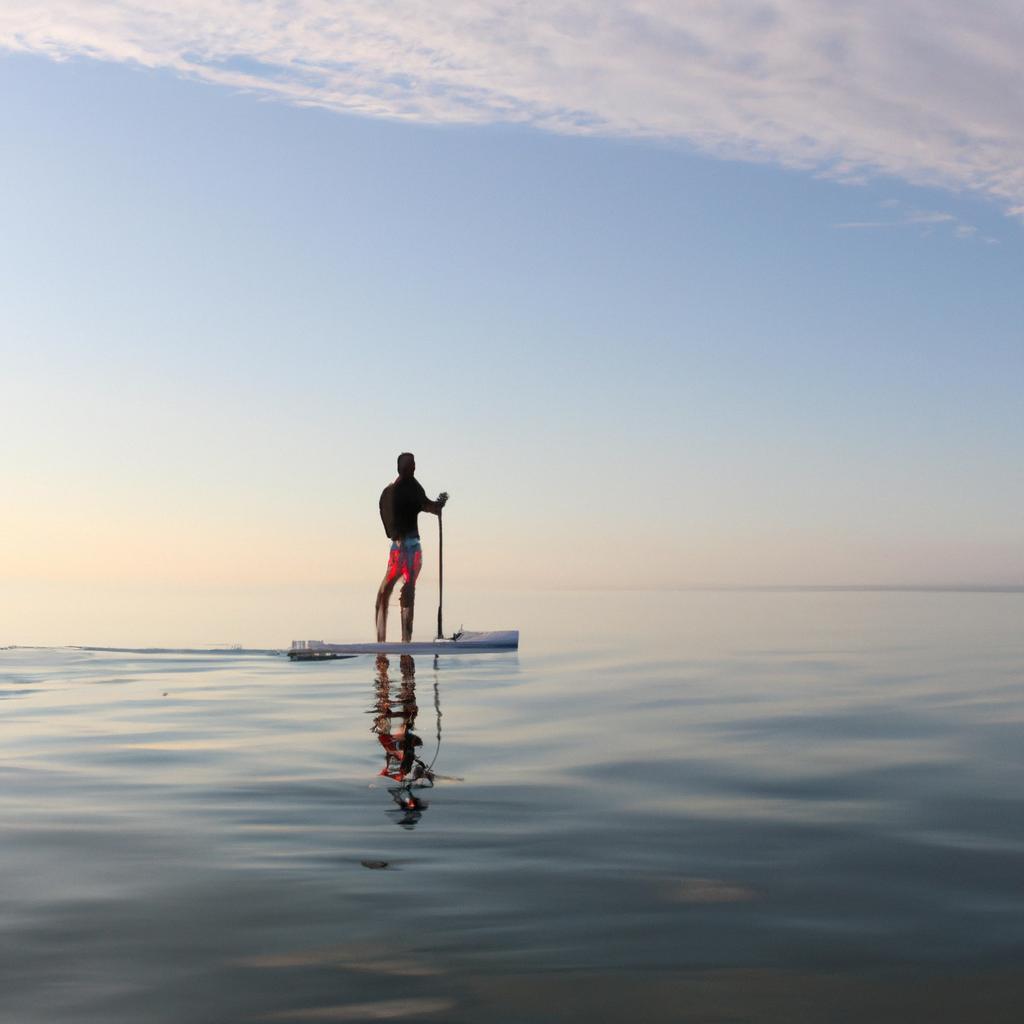
Paddleboarding has gained significant popularity in recent years as a recreational water sport and an effective method of physical fitness. With its origins rooted in ancient Polynesian culture, paddleboarding has evolved into various disciplines, including flatwater touring, racing, and even yoga. However, mastering the techniques required for efficient paddleboarding is essential to fully enjoy the experience while minimizing the risk of injury or exhaustion.
For instance, imagine a beginner embarking on their first paddleboarding adventure along a calm lake. Lacking proper technique and knowledge, they struggle to maintain balance on the board and find it challenging to maneuver through gentle waves. Without adequate guidance and understanding of fundamental techniques such as stance, paddling strokes, and body positioning, this individual may become discouraged and miss out on truly experiencing the joy and tranquility that paddleboarding can offer.
This comprehensive guide aims to provide aspiring paddleboarders with valuable insights into mastering the essential techniques necessary for successful paddling. By exploring topics such as proper equipment selection, correct posture and alignment, effective stroke mechanics, and advanced maneuvers like turning and bracing, readers will gain a solid foundation upon which they can build their skills. Whether you are a complete novice or seeking to improve your existing abilities, this article offers practical advice based on years of experience and expert knowledge in the field.
One of the first steps towards becoming a proficient paddleboarder is selecting the right equipment. This guide will walk you through choosing the appropriate board size, paddle length, and other essential accessories to ensure maximum comfort and efficiency on the water. Understanding how different board shapes and materials can impact stability and performance will help you make an informed decision when making a purchase.
Once equipped with the proper gear, we will delve into the fundamental techniques required for successful paddling. Starting with finding your optimal stance and maintaining balance on the board, we will then explore various paddling strokes, including forward stroke, reverse stroke, sweep stroke, and draw stroke. Clear instructions accompanied by illustrations or videos will provide visual aids to facilitate learning.
In addition to mastering basic strokes, this guide will also cover advanced maneuvers like turning and bracing. Learning how to execute efficient turns using techniques such as pivot turns or sweeping turns will enhance your maneuverability on the water. Furthermore, understanding bracing techniques can help you maintain stability when encountering waves or rougher waters.
To ensure safety during paddleboarding excursions, we will address important considerations such as proper hydration and sun protection. Additionally, tips for navigating currents or wind conditions will be provided to help you confidently handle various situations while minimizing risks.
Lastly, this comprehensive guide recognizes that paddleboarding offers more than just physical exercise; it can also be a means of connecting with nature and finding inner peace. We will explore incorporating mindfulness practices into your paddleboarding routine and even introduce SUP yoga poses for those seeking a unique blend of fitness and tranquility.
By following this guide’s step-by-step instructions and practicing regularly, you will gain confidence in your abilities as a paddleboarder. Whether you aspire to leisurely cruise along calm waters or participate in competitive racing events, mastering these essential techniques is key to fully enjoying all that paddleboarding has to offer. So grab your board, paddle, and a sense of adventure – it’s time to embark on an exciting journey towards becoming a skilled paddleboarder.
Choosing the Right Paddleboard
Imagine this scenario: You are standing at the edge of a serene lake, ready to embark on your paddleboarding journey. The sun is shining brightly overhead, and you can feel the excitement building within you. However, before you can take that first step onto the board, it is crucial to choose the right paddleboard that suits your needs and abilities.
To make an informed decision about which paddleboard to select, there are several factors to consider. Firstly, think about your skill level and experience with paddleboarding. Are you a beginner looking for stability and ease of use? Or perhaps you are an advanced paddler seeking speed and maneuverability? Understanding your proficiency will help guide you towards the appropriate type of board.
Secondly, consider where you plan to use your paddleboard. Will it mainly be used in calm lakes or ponds? Or do you envision riding waves in the ocean? Different environments call for different designs, so ensure that your chosen board matches the intended conditions.
Additionally, take into account your body weight and size when selecting a paddleboard. A heavier person may require a wider and more buoyant board for better stability, while a lighter individual might opt for a narrower model for increased agility.
Lastly, contemplate any additional features or accessories that could enhance your overall experience. These could include built-in storage compartments for personal belongings or attachment points for securing gear such as water bottles or cameras.
By carefully considering these factors – skill level, environment usage, body weight/size, and desired features – you can confidently choose a paddleboard tailored specifically to meet your needs. Once equipped with the perfect board suited to navigate various waterscapes flawlessly, you will be one step closer to mastering proper paddle strokes in our next section.
Factors to Consider When Choosing a Paddleboard:
- Skill Level
- Environment Usage
- Body Weight/Size
- Desired Features
| Skill Level | Environment Usage | Body Weight/Size | Desired Features |
|---|---|---|---|
| Beginner | Calm lakes | Heavier | Storage Compartments |
| Intermediate | Ponds | Lighter | Attachment Points |
| Advanced | Ocean |
With the right paddleboard in your possession, you are ready to dive into mastering proper paddle strokes. This next section will provide you with essential techniques and tips to enhance your paddling skills, allowing you to glide effortlessly through the water.
Prepare yourself for a rewarding journey as we delve deeper into the art of paddleboarding.
Mastering Proper Paddle Strokes
Having chosen the right paddleboard, it is now time to delve into the crucial aspect of mastering proper paddle strokes. By understanding and implementing correct paddling techniques, you will not only improve your efficiency on the water but also enhance your overall experience as a paddleboarder.
Paragraph 1:
To begin with, let’s consider the importance of maintaining a strong core while paddling. A strong core provides stability and balance, allowing for more effective stroke execution. Picture this scenario: imagine you are out on the open water, attempting to navigate through choppy waves without engaging your core muscles. As a result, each stroke becomes arduous and less efficient, making it harder to control your board’s direction. By engaging your core throughout each stroke, you create a solid foundation from which to generate power and maintain control.
In order to maximize your paddleboarding experience and prevent potential injury or discomfort caused by incorrect technique, keep in mind these key elements:
- Proper hand placement on the paddle shaft
- Engaging both arms evenly during each stroke
- Rotating your torso rather than relying solely on arm strength
- Positioning the blade at an angle that allows for maximum forward propulsion
Paragraph 2:
Let’s take a moment to examine how these principles translate into action. Consider this hypothetical situation: You find yourself surrounded by serene waters as you embark on a picturesque sunrise paddle session. As you dip the blade smoothly into the water with one hand placed slightly above shoulder height and the other firmly gripping lower down on the shaft, you feel an immediate connection between your body and board. With each deliberate rotation of your torso, propelling yourself forward becomes effortless; every stroke glides seamlessly through the water’s surface, creating minimal resistance.
Emphasizing these fundamental aspects of proper paddling technique can make all the difference in achieving optimal performance and enjoyment while paddleboarding. To further illustrate their significance, here is a table highlighting the benefits of mastering correct paddle strokes:
| Benefits of Proper Paddle Strokes |
|---|
| Increased efficiency |
| Enhanced maneuverability |
| Reduced fatigue |
| Improved overall control |
Paragraph 3:
By focusing on these principles and integrating them into your paddling routine, you will gradually develop a fluid stroke that aligns with your body’s natural movements. As you progress in skill level, these techniques will become second nature, allowing you to fully appreciate the tranquility and exhilaration offered by this water sport.
With a solid foundation in proper paddle strokes established, let’s now turn our attention to exploring essential balancing and stance techniques for paddleboarding.
Balancing and Stance Techniques
Having established a solid foundation in paddleboarding techniques, let us now delve deeper into mastering proper paddle strokes. By understanding and honing these fundamental skills, you will be able to navigate through the water with greater efficiency and precision.
Paragraph 1:
To illustrate the importance of proper paddle strokes, consider this hypothetical scenario: imagine yourself on a serene lake, gliding across its glassy surface. As you push your paddle into the water, you notice that instead of propelling forward smoothly, your board veers off course. This misdirection not only disrupts your balance but also hampers your progress towards enjoying the tranquility of the surroundings. By acquiring proficiency in different types of paddle strokes, such as the forward stroke and reverse stroke, you can effortlessly maneuver your board while maintaining stability.
Paragraph 2:
When it comes to executing effective paddle strokes, there are several key principles to bear in mind:
- Body posture: Adopting a relaxed yet engaged stance allows for optimal power transfer during each stroke.
- Grip technique: Hold the paddle correctly by placing one hand on top of the grip and the other hand slightly lower down near the blade’s shaft.
- Blade entry angle: Ensure that when inserting the blade into the water, it enters at an angle perpendicular to avoid unnecessary resistance.
- Pull-through motion: Maintain consistent pressure against the water throughout each stroke before exiting cleanly close to your feet.
By adhering to these guidelines and practicing diligently, you will gradually refine your technique and experience enhanced control over your movements on the water.
Paragraph 3:
Engaging in regular practice sessions focused specifically on perfecting paddle strokes is crucial for every aspiring paddler. Remember that mastery often stems from patience and persistence rather than immediate results. Embrace trial-and-error as part of your learning process; remain adaptable to adjustments required for various conditions like wind, waves, and currents. Developing a strong foundation in mastering proper paddle strokes will serve as the bedrock for your future progress in navigating different water conditions.
As you continue honing your skills on the board, it is essential to explore techniques for navigating various water conditions effectively. Understanding how to adapt your strokes and maintain balance amidst changing environments ensures that you can confidently tackle any challenge that comes your way.
Navigating Different Water Conditions
Building upon your newfound knowledge of balancing and stance techniques, let’s now explore the crucial skill of navigating different water conditions. Imagine yourself paddling through calm waters on a serene lake, only to encounter strong waves as you venture further into the open sea. By understanding how to adapt your technique in varying water conditions, you can enhance your paddleboarding experience and ensure safety.
When it comes to mastering paddleboarding techniques, adjusting your approach based on the current water conditions is essential. Here are some key considerations:
-
Wave Management: As waves grow larger or more turbulent, maintaining stability becomes increasingly challenging. To effectively navigate such conditions:
- Position yourself slightly forward on the board for better control.
- Engage your core muscles while keeping your knees slightly bent to absorb shock from crashing waves.
- Use a wider stance with your feet positioned parallel to each other for increased stability.
- Practice timing your strokes to match the rhythm of incoming swells for smoother rides.
-
Windy Environments: Strong winds can significantly impact paddleboarding performance and direction. Follow these guidelines when faced with windy conditions:
- Adjust your body posture by leaning into the wind at an angle to counterbalance its force.
- Choose shorter and quicker strokes rather than longer ones that may be affected by gusts.
- Maintain a low center of gravity by bending your knees slightly throughout each stroke.
-
Challenging Currents: When dealing with powerful currents, it is crucial to adapt accordingly:
- Utilize cross-strokes (diagonal paddle strokes) against the current for better maneuverability.
- Keep an eye out for eddies or areas where currents flow differently—these can provide temporary relief or assistance.
- Be aware of potential hazards such as submerged rocks or debris carried by fast-moving currents.
Remember that adapting to changing water conditions requires practice and experience. By honing your skills in different environments, you will become a more confident and versatile paddleboarder.
Now that we have covered the fundamentals of navigating various water conditions, let’s delve into advanced paddleboarding techniques to further elevate your expertise on the board.
Advanced Paddleboarding Techniques
Imagine you are a paddleboarder on a serene lake, gliding effortlessly across the calm waters. Suddenly, the wind picks up and waves start crashing against your board, challenging your balance and control. This scenario highlights the importance of mastering different water conditions while paddleboarding. In this section, we will explore various techniques to help you confidently tackle any type of water condition.
To begin with, let’s discuss how to handle choppy or rough waters. These conditions can be intimidating for both beginners and experienced paddlers alike. To maintain stability in such circumstances, it is crucial to adopt a wider stance on your board. By spreading your feet apart, you create a solid base that enhances your balance and minimizes the risk of falling off. Additionally, keeping a slight bend in your knees allows for better shock absorption as your board encounters turbulent waves.
When facing strong winds during paddleboarding, proper positioning becomes essential. Position yourself towards the front end of the board rather than in its center. This adjustment helps prevent being blown off course by allowing you to lean into the wind for stability. Furthermore, using shorter strokes with increased cadence enables quicker maneuvers and better control over your direction.
In addition to these techniques, here are some key considerations when navigating different water conditions:
- Be aware of tide patterns: Familiarize yourself with tidal movements before heading out onto the water.
- Use landmarks or buoys as reference points: They can assist in maintaining direction amidst changing currents or strong winds.
- Practice balancing exercises: Strengthening core muscles through regular workouts can greatly enhance stability while paddleboarding.
- Stay updated on weather forecasts: Being well-informed about upcoming weather conditions ensures preparedness and safety.
Embracing varying water conditions requires adaptability and skillful maneuvering. The table below summarizes common types of water conditions along with recommended strategies:
| Water Condition | Recommended Strategy |
|---|---|
| Calm and flat | Focus on technique improvement and build endurance. |
| Windy with small waves | Employ a wider stance, lean into prevailing winds, and use shorter strokes for better control. |
| Rough waters with large waves | Maintain balance through an even wider stance, engage core muscles, and adopt a more aggressive stroke pattern. |
| Challenging currents or strong tides | Utilize landmarks or buoys as reference points to maintain direction. |
By mastering the techniques outlined above and considering these tips, you will be better equipped to navigate various water conditions while paddleboarding. In our next section, we will delve into essential safety measures and injury prevention guidelines to ensure your overall well-being during this exhilarating activity.
Tips for Safety and Injury Prevention
Transition from Previous Section:
Having explored advanced paddleboarding techniques, let us now shift our focus towards ensuring safety and preventing injuries. By following essential guidelines and adopting precautionary measures, paddlers can enjoy their time on the water while minimizing potential risks.
Section: Tips for Safety and Injury Prevention
To emphasize the importance of safety practices, consider a hypothetical scenario where a novice paddleboarder ventures into unfamiliar waters without proper knowledge or equipment. As they encounter challenging conditions, such as strong currents or unexpected obstacles, their lack of preparation could lead to accidents or injuries. To avoid such unfortunate incidents, it is crucial to adhere to the following safety tips:
- Wear a Personal Flotation Device (PFD): Always wear an approved PFD when paddleboarding, even if you are confident in your swimming abilities.
- Check Weather Conditions: Prioritize checking weather forecasts before heading out onto the water. Avoid venturing into open bodies of water during storms or high winds.
- Stay Hydrated: Bring sufficient drinking water to stay hydrated throughout your paddleboarding session. Dehydration can impair judgment and increase fatigue.
- Know Your Limits: Assess your skill level honestly and choose appropriate locations and conditions accordingly. Gradually progress towards more challenging environments as you gain experience.
In addition to these safety tips, incorporating injury prevention strategies is equally vital for maintaining optimal well-being while paddleboarding. Consider implementing the following practices:
| Pre-Paddle Warm-Up | Proper Technique | Regular Maintenance | |
|---|---|---|---|
| 1 | Engage in dynamic stretches that target major muscle groups involved in paddleboarding. | Ensure correct posture and body mechanics during strokes to minimize strain on joints. | Regularly inspect paddleboard equipment for any signs of damage or wear-and-tear. |
| 2 | Perform light cardiovascular exercises like jogging or jumping jacks prior to getting on the board. | Utilize the power of your core muscles, engaging them to generate efficient paddle strokes. | Keep the fin and leash secure on your board to prevent accidents or equipment failure. |
| 3 | Focus on stretching lower back, shoulders, and legs to improve flexibility before paddling. | Practice balance exercises off the water to enhance stability while standing on the board. | Rinse your paddleboard with fresh water after each use to remove any saltwater residue that may corrode it over time. |
| 4 | Incorporate strength training for upper body and leg muscles into your fitness routine. | Take regular breaks during extended sessions to rest and stretch, reducing muscle fatigue. | Store your paddleboard in a cool, dry place away from direct sunlight when not in use. |
By implementing these safety tips and injury prevention strategies, you can ensure a safe and enjoyable paddleboarding experience. Remember, prioritizing caution and preparation is key to making the most out of every adventure on the water.

